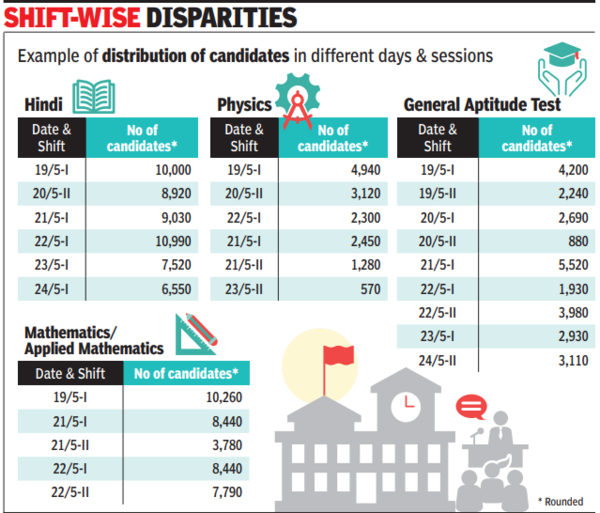NEW DELHI: Even as CUET-UG 2025 results are awaited, the conduct of the exam has raised concerns over biometric verification gaps, shift-wise disparities such as uneven distribution across test sessions—which raised doubts over distorted percentile-based normalisation potentially impacting merit rankings and admission chances—and deviations from the declared syllabus, including changes to question paper formats without prior notice. These have drawn sharp criticism from candidates, parents, and education experts, who say the exam fell short on basic fairness, syllabus integrity, and identity verification protocols—many of which had been explicitly recommended by a government-appointed high-level committee headed by former ISRO chief K Radhakrishnan.One of the committee’s core recommendations was multi-stage candidate verification, including Aadhaar-based biometric authentication, to prevent impersonation. It stated: “Biometric data of candidates must be matched with Aadhaar Card information (maybe done offline after acquisition of biometric data).” The National Testing Agency (NTA), in response to queries from the TOI, confirmed that not all biometric authentications were conducted at the entry gate. Instead, the agency stated that Aadhaar details were validated during the online application process for 96% of the 13.54 lakh registered candidates, and that biometric data and photographs were captured inside the exam hall due to time constraints between shifts.

“Aadhaar details were successfully matched for 96% of the 13.54 lakh registered candidates. In JEE (Main), the set of candidates in each of the two shifts is distinct. However, in CUET-UG, there was a significant likelihood that candidates appearing in the first shift also appeared in the second shift on the same day… In such a case, it would not be appropriate to ask students to report for the second shift immediately, thereafter, as taking biometrics requires more time…,” the NTA said.NTA also said that “For CUET UG 2025, Aadhaar validation was performed only when the candidate’s name, date of birth, and gender matched during online registration,” which indicate that photographs of the candidates were not matched with the Aadhaar data neither at the time of registration or during the exam which could lead to potential impersonation as goes against the committee’s recommended authentication protocol.This approach leaves a verification gap for the remaining 4% of candidates. More importantly, the Radhakrishnan report called for authentication—not just biometric capture—which is central to preventing impersonation. The report stated, “Essentially, multi-stage authentication of candidate’s identity is envisaged which makes use of Aadhaar, biometrics, and AI-based data analytics,” laying out a detailed authentication protocol.Another area of concern is the uneven shift-wise distribution of candidates, which could undermine the percentile-based normalisation process. For instance, based on attendance documents accessed by TOI, the physics paper had nearly 5,000 candidates in one shift and around 570 in another, with similar variations seen in mathematics and the general aptitude test. While NTA did not provide subject and session-wise data, it said that “sample sizes were sufficiently large” and cited the English test, where around 43,000 candidates were accommodated in each shift.This raises a critical statistical issue: normalisation assumes comparable cohorts. If sample sizes differ significantly across shifts, percentile rankings may not accurately reflect relative difficulty levels. The question remains unanswered: can a topper among 10,000 candidates be equated with one among 3,000?On the syllabus front, for physical education, the official syllabus uploaded by NTA states that candidates should, while naming the sports, opt for “one of your choice” for Unit 3. However, students reported that the questions were mandatory with no option. When asked, NTA did not address the syllabus deviation directly. Instead, it stated: “For Physical Education, the panel of subject experts decided not to provide options in Unit 3, as offering choices across 15 different sections was deemed impractical… Questions included in the paper were fundamental in nature… No undue advantage was given to any candidate during the conduct of the examination.” The response didn’t explain why this change wasn’t notified in advance.When it comes to infrastructure integrity, the Radhakrishnan Committee had advised that test centres be vetted by district-level committees. NTA claimed that the same centres used for JEE (Main) Session II were reused and had been verified by respective district authorities. However, some deputy commissioners reportedly denied knowledge of any such process. In response, NTA stated: “The centres used for JEE (Main) 2025 Session I and Session II were utilized for CUET-UG 2025. All centres were audited, inspected, and verified by the district-level committee for Session II conducted in April 2025.” To the question “…substantiate with reports of DC as not all centres can be common,” NTA did not provide any audit reports. However, it admitted, “While some technical glitches occurred, they were purely of a technical nature. All the candidates were provided full time to appear in the examination.”Similarly, in economics, microeconomics questions — typically taught in Class XI — were included, despite CUET-UG being advertised as based on the Class XII syllabus. NTA’s response was that the questions were based on the NCERT curriculum, which includes both micro and macro topics. Yet students point out that microeconomics was added to the CUET syllabus only in March 2025, well into the academic year, reducing preparation time and the comparatively double the weightage than last and ignoring the proportion of mic and macro across different sets disadvantaging those who followed the original syllabus. NTA said that “CUET (UG) 2025 syllabus is purely based on NCERT textbooks, and questions were framed from both the sections of macro and microeconomics to assess the candidates.”At one Kanpur centre where the exam was cancelled, students say they are still waiting for a formal notice. NTA responded that all affected candidates were informed individually via SMS, phone, and email, but did not publish any public communication or advisory online. “Their exams were rescheduled… successfully conducted within the scheduled timeframe,” the agency said.While NTA maintains that CUET-UG 2025 was conducted “successfully” with approximately 78% attendance, several of these issues have cast doubt on the exam’s ability to uphold the principles of fairness, transparency, and comparability—critical to high-stakes entrance testing.





